#do html tags even work on mobile??
Explore tagged Tumblr posts
Text
Don't know how to describe this any better than 'echolalia with no source*' but the phrase <br> "she loves me for my gormless swag and withered bod" <br> was fucking HAUNTING my skull endlessly on loop the other nightshift.
*the source is my brain scramblies
#do html tags even work on mobile??#who knows but I can't fucking shift+enter to make a line break instead of a full paragraph break on mobile so I'm damnèd ig
0 notes
Note
How old does your blog have to be to see the desktop blog view thing?
You can just make it happen whenever you want!
In your browser, set it to desktop mode (available in the dropdown dots menu) and then just type in a user's name first, then tumblr.com
Example:
Fangirltothefullest.tumblr.com
If they have set up a desktop version it'll show
Users older than when mobile became a thing will have desktop versions as they are more customizable. You could even add music if you had the html code for a player.
If you wsnt one yourself, you have to enable custom themes.
Log into tumblr on your browser either on desktop or on mobile. I suggest logging in through desktop mode on your phone's web browser and opening the log in in a new tab so it stops trying to pop up the app.
Once logged in you can disable desktop mode in your browsers drop down to see things easier.
It'll probably up like this otherwise and be a formating nightmare.
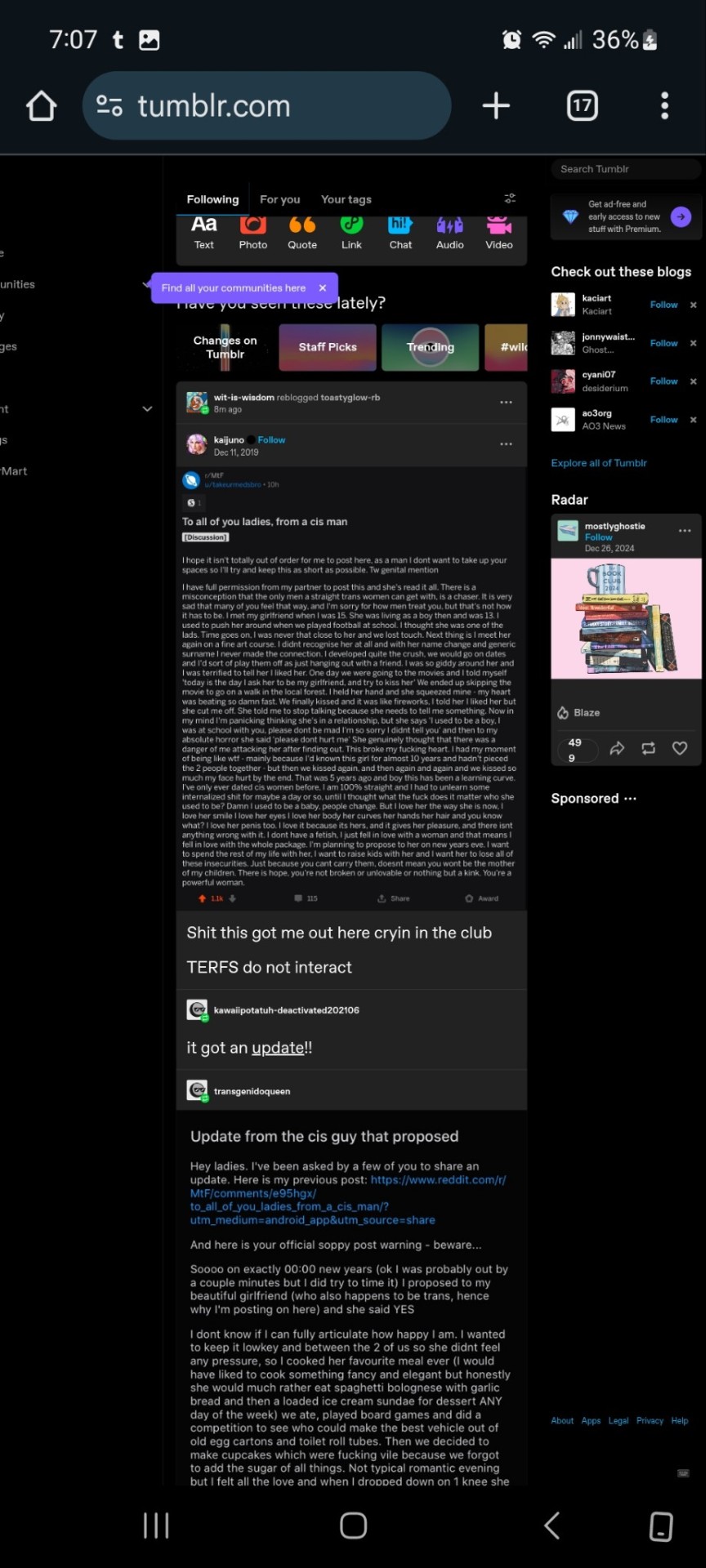
Now.... once it's OFF desktop mode,
Go to the blog you want and hit blog settings in the drop down.
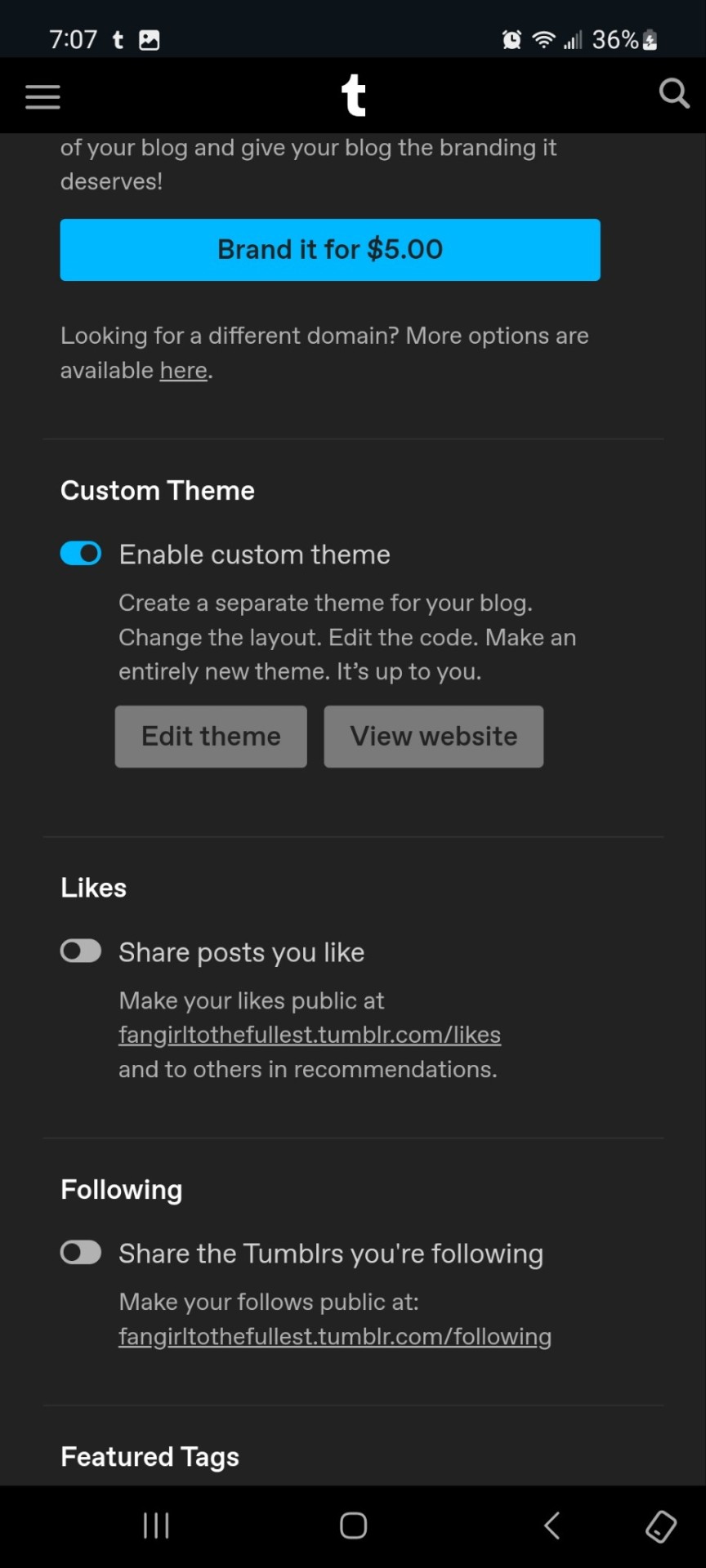
Enable the custom theme and hit the edit theme button. You'll be taken to a place that looks likethis:
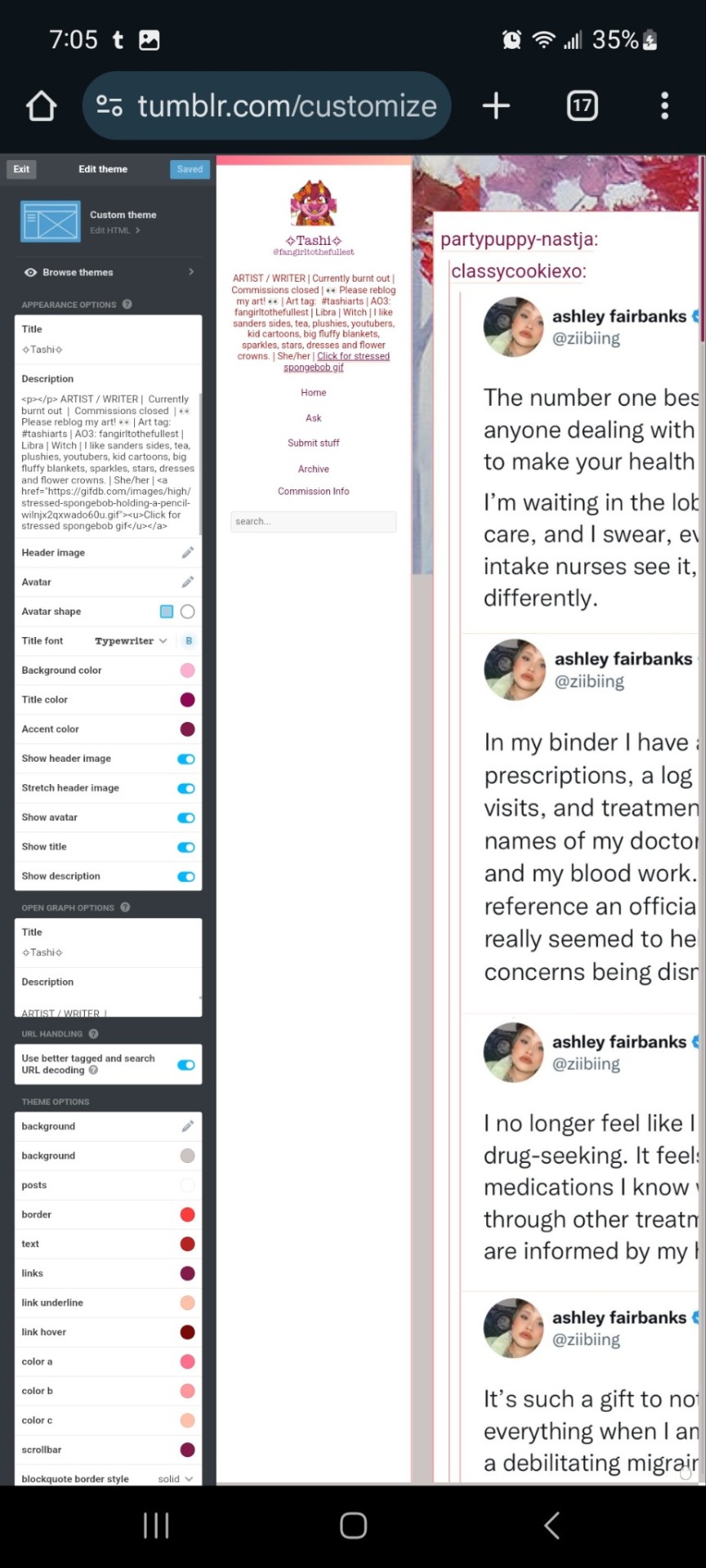
You can zoom in to hit the browse themes button:
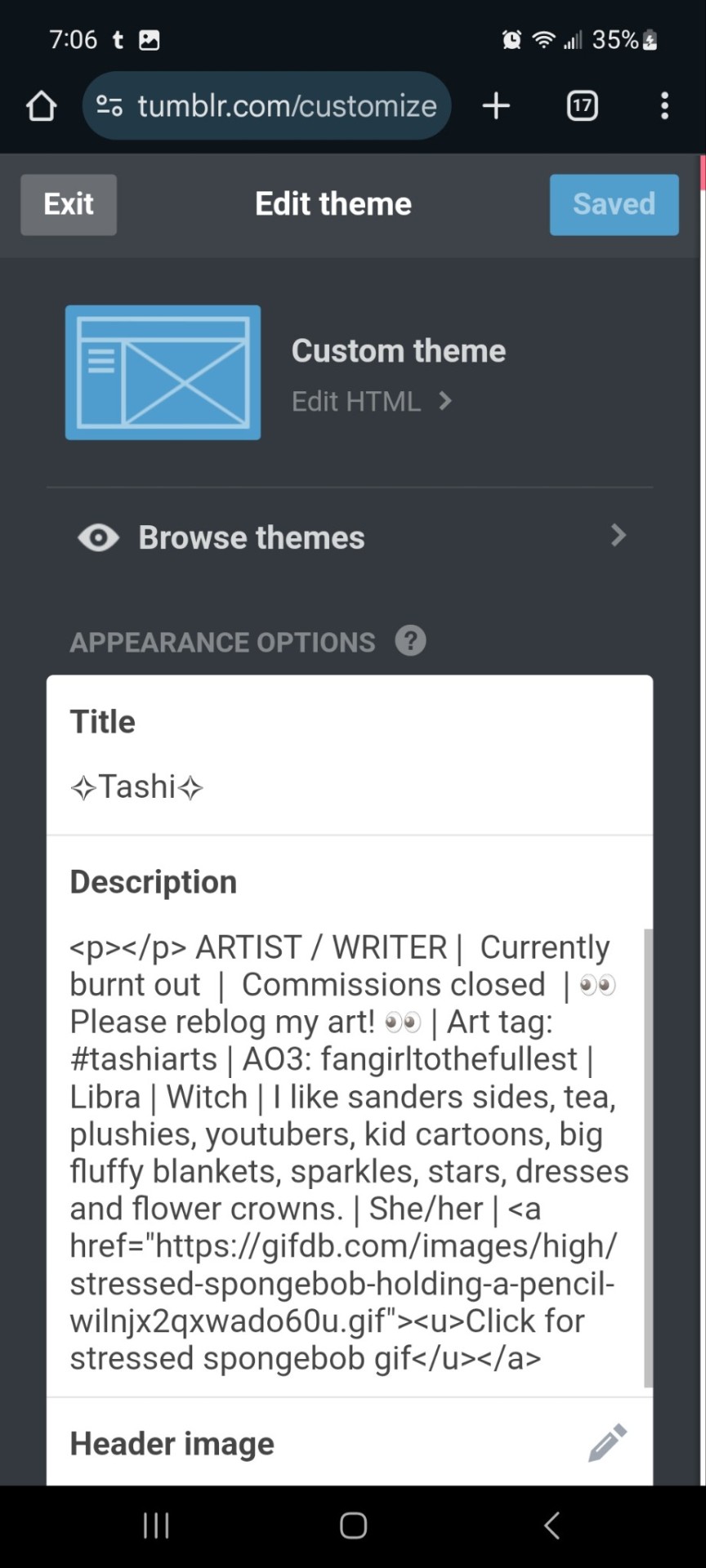
It'll bring you here:
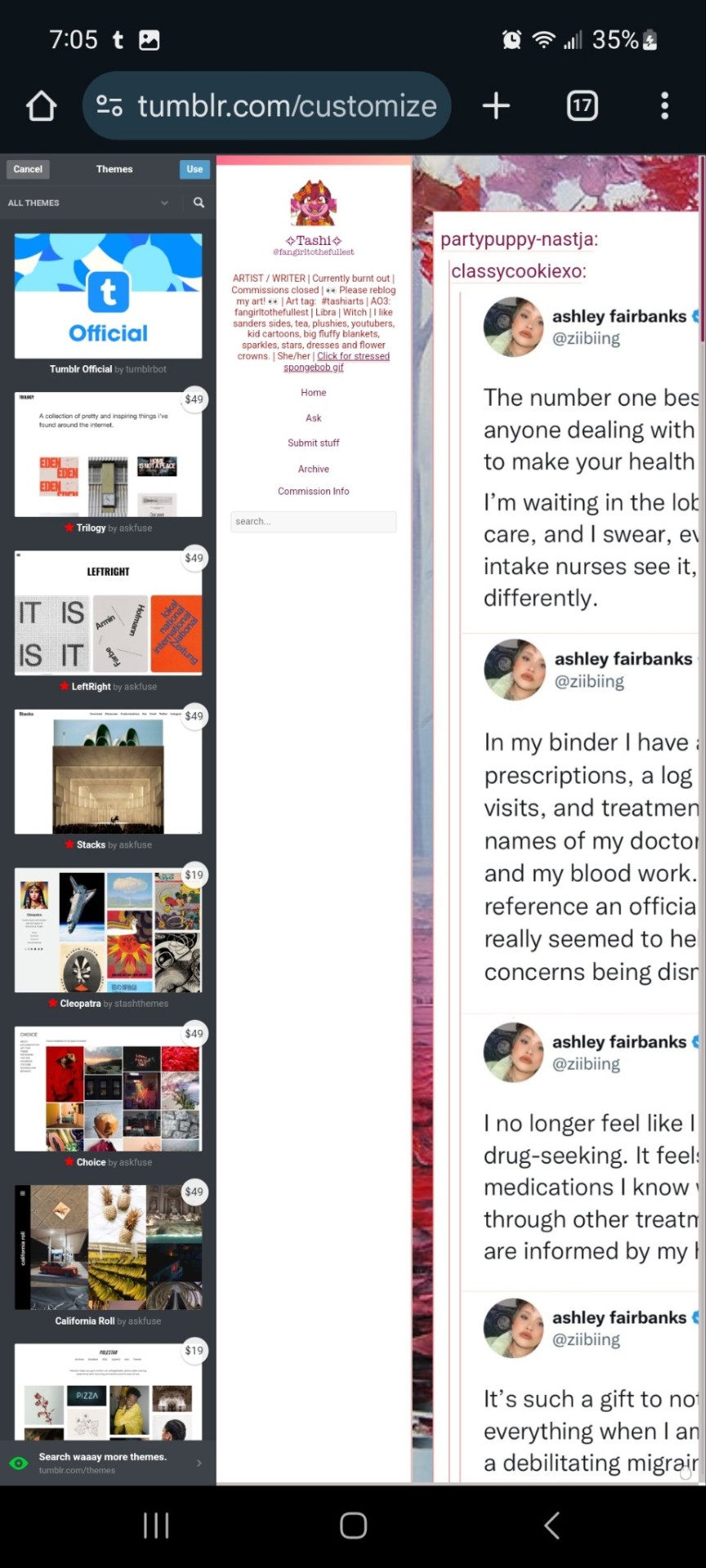
And you can choose what style you want! Hit save and you'll notice it gives you options to play around- choose a background, colour scheme. Fonts etc. Play with the html!
On a regular desktop this is easier to see so I suggest doing this on a laptop or pc.
Also fun fact you can hide secret messages in the html coding and if someone pops open the page source they'll see the surprise message in the code. XD just a fun thing if anyone wants to... say... make their own arg or send out secrets etc.
You CAN create whole pages with this feature too but they are unreliable and after this long it might be broken? So... yeah.
NOW REMEMBER: TO ACCESS THE DESKTOP PAGES YOU HAVE TO CHANGE THE LINK!
Forfeature. As a said above, my desktop link is fangirltothefullest.tumblr.com
I believe the mobile version has it as tumblr.com/fangirltothefullest.
Only people who have made a desktop version will have their blog show up if you'd like to test this festure.
Also this is how you access everyone's blog archive! Because blog archives exist!
Mine would be:
Fangirltothefullest.tumblr.com/archive and you can't open it in mobile or it'll just pop up the mobile version which doesn't exist.
You wsnt this page which let's you find the earliest things a blog has posted. So I created this blog in june 2012 lol.
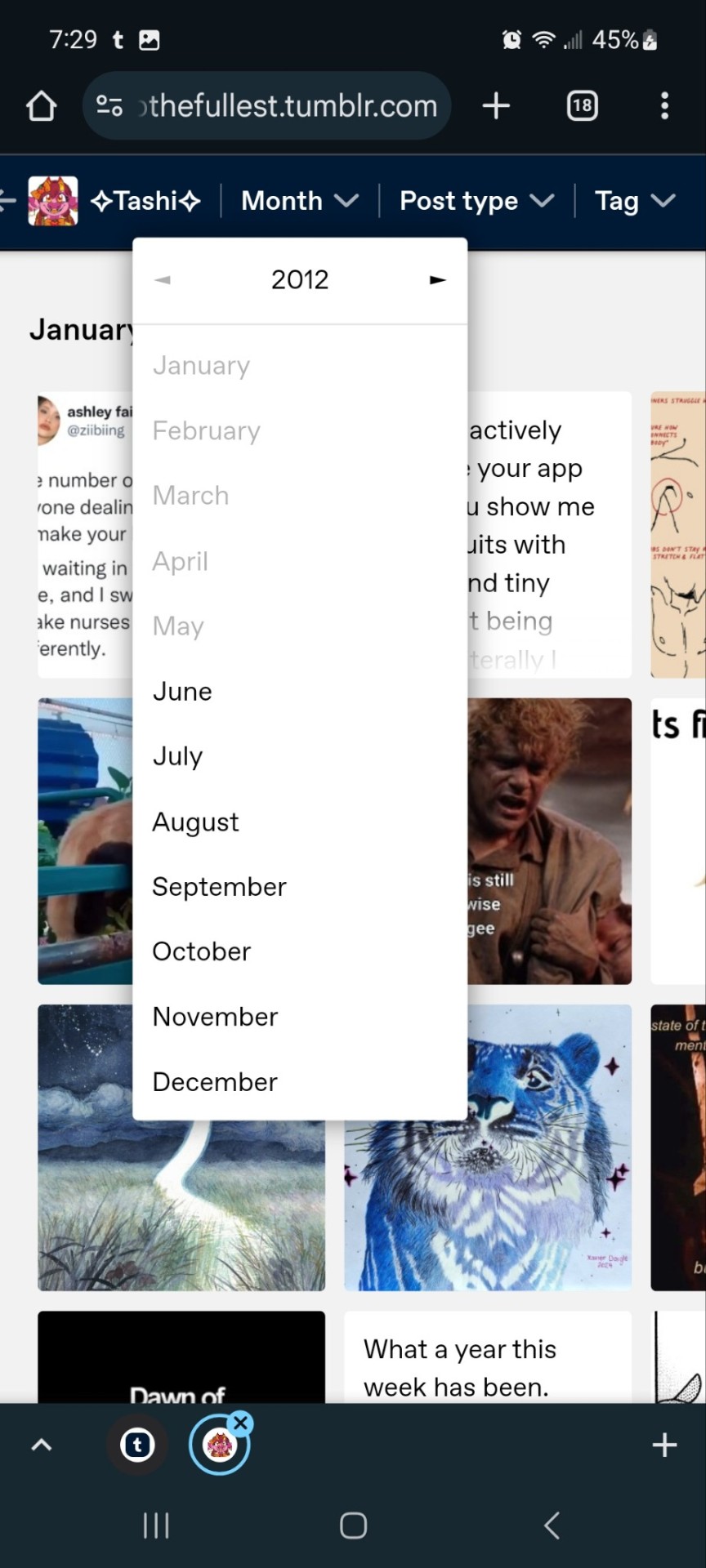
It works for tags too to show you ONLY the contents of that specific tag
Fangirltothefullest.tumblr.com/tagged/tashiarts/
And if you want a tag in order you add /chrono to the end to get it chronologically sorted from the earliest posts in the tag.
Fangirltothefullest.tumblr.com/tagged/tashiarts/chrono
I hope this helps!
NOW EVERYOE GO HAVE FUN MAKING COOL DESKTOP VERSIONS OF YOUR BLOGS!
32 notes
·
View notes
Note
What's rentry and strawpage? How do they work? Yours are verte cute btw 🩷
thank you so much !! i can't define them myself but rentry and strawpage are often used to create pages online, both following different formats. putting my explanation under the cut to not clog the dash
rentry relies on html, which they explain how to do on their page! it's more complicated than strawpage and isn't as "freehanded", but it gets the work done even if you aren't making it aesthetic. most of the decoration on mine relies on the "metadata" element, which is a whole another can of worms but i managed. expect to type a lot. it doesn't require an account, but you do need a password for your pages to be saved/edited!
strawpage requires an account, and sites can easily be created through desktop or mobile. they have a set of templates you can choose from, or you can just freehand it. it's fairly easy to use once you get the hang of it, i recommend having a lot of pngs/pictures on hand. you can also add an ask box and have a box for people to draw things for you that'll be filed under the "gimmicks" tag. as far as i know, strawpage only allows 2 "sites" per user.
it depends all on you, but despite me using rentry for a long while, i'd recommend strawpage on the account that it's more beginner-friendly and has a lot more customization options in comparison. rentry if you can handle a lot of typing and are up for a challenge.
unlike strawpage, rentry doesn't allow you to upload pictures on site hence the coding/markdown aspect so i recommend using catbox to store any potential pixels or backgrounds you're gonna use.
7 notes
·
View notes
Text
How to Embed Images and Links on AO3
Note: I have a site skin so the colors might look different. Just follow along with the red arrows! Also, this is a tutorial used on the computer, and I assume mobile posting would be different.
First, open archiveofourown.org and log in if you haven't already. If you don't have an AO3 account, sign up for one as soon as possible because it takes about a week for them to verify you and give you access to your new account.

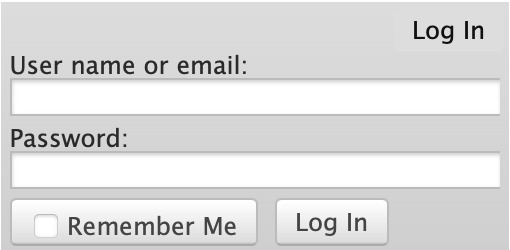
Next, select "Post" in the top right hand corner like you would typically. Set up everything you desire as you normally would until you reach "Work Text*".
Note: If you need further help, I have an AO3 Tag Guide, a Story Title Guide, a List of Random AO3 Shortcuts, and a How to Post a Work on AO3 with Step-by-Step Explanations Guide for your convenience! I also have a Foundations Writing Lesson post for any beginners or for people who would appreciate a review <333

Once there, click on "Rich Text" in the top right of that section, and then select the image icon or the link icon, depending on which you are intending to make.
Note: Check under the cut for more in-depth instructions slash a continuation of this guide! There is an Image Icon Route and a Link Icon Route.

Image Icon Route
Once you click on the Image Icon, the screen similar to below should pop-up:
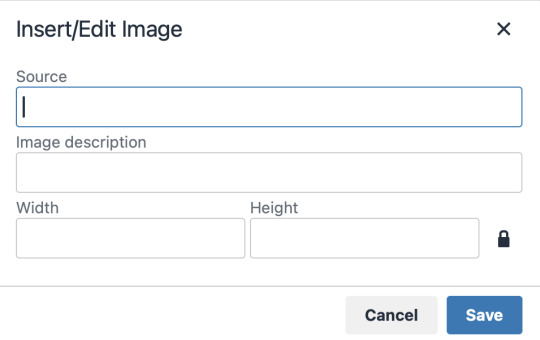
*Link Icon Route detour start here
The source is the link to the image you're wanting to add to your work. AO3 doesn't host images itself, but you can use an image hosting site such as postimages.org or even Tumblr itself. If you want to use Tumblr, post a draft with the desired image or locate a post with the desired image. Once you've done that, right click the desired image and Open Image in New Tab (or whatever your computer's equivalent is).
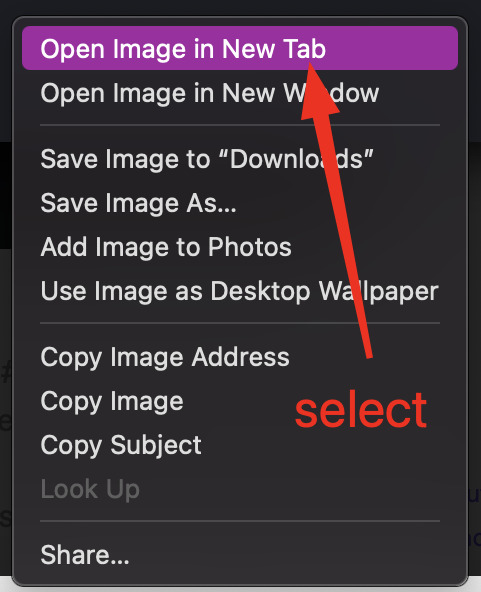
You should have a tab open that starts with "https://64.media.tumblr.com" followed by a bunch of numbers and letters. I want you to copy that link and post it in the source box.

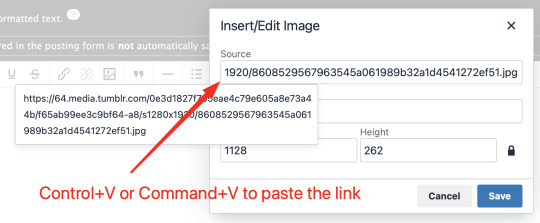
*Link Icon Route detour ends here
Now that the image link is in place, adjust your Width/Height boxes if desired. Feel free to add an image description as well. For best result, I suggest doing 100% in the Width box with nothing in Height, but this is ultimately a personal decision. Feel free to mess around with the proportions using the work drafts and find what's best for you!
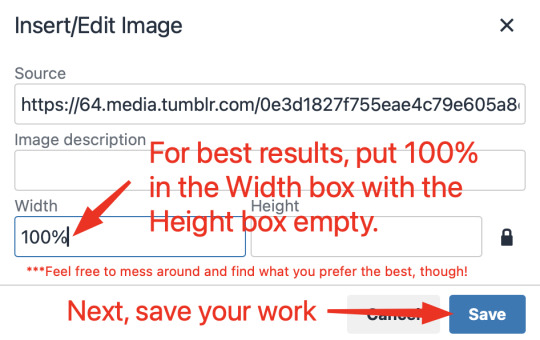
If you prefer, you can also use < img src="LINK" alt="IMAGE DESCRIPTION" width="100%" align="center" /> aka < + img src="https://64.media.tumblr.com/0e3d1827f755eae4c79e605a8e73a44b/f65ab99ee3c9bf64-a8/s1280x1920/8608529567963545a061989b32a1d4541272ef51.jpg" alt="" width="100%" align="center" /> for this example (*excluding the plus sign at the start) to insert an image using HTML instead of Rich Text. It'll look like this:

It is always a good idea to double-check and confirm that everything is how you want it. Previewing your work also allows you to create a draft.
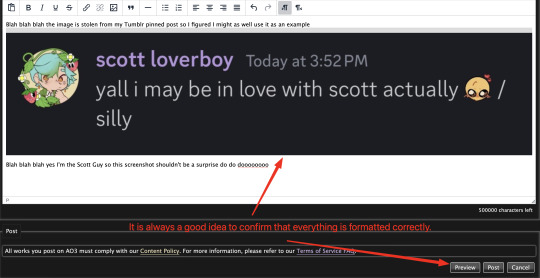

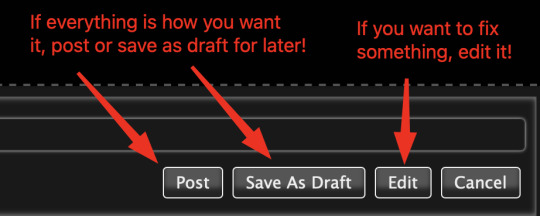
If you're unhappy with something, edit the work to fix it! If you're happy with how everything looks, go ahead and post it! You're finished here! You've successfully posted a work with an image embedded! Well done; good job :D
Link Icon Route
Once you click on the Link Icon, the screen similar to below should pop-up:
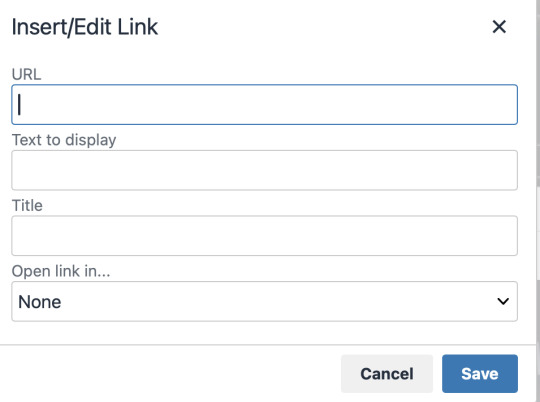
Go copy (Control+C or Command+C) the link to whatever it is you want to insert into the body of the work.
Note: If you're wanting to link specifically to an image and not a post containing that image, scroll up to the link icon route detour colored purple.
Once you got that, paste (Control+V or Command+V) the link into the URL box. If you want something other than the link to display, change the text in the "Text to display" box.
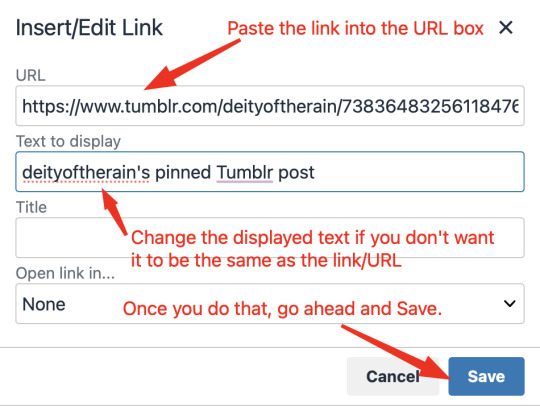
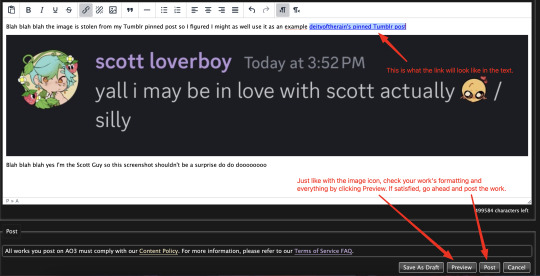
Save your work, check the formatting and everything else like we did in the Image Icon Route section. If everything is how you want it, then congratulations! You have successfully added a link embedded to your work!
If you have any questions or comments, feel free to comment and I'll respond! If this guide was helpful to you, please like and reblog! I appreciate it <333
#rain’s tips#ao3 author#ao3 help#ao3 writers#ao3#archive of our own#embedded#images#links#ao3 link#ao3 images#ao3 guide#idk how to tag this#idk what tags to use#writing help#guide
17 notes
·
View notes
Note
wahhh perfect timing thank you so much for letting us come to you for help 🥲
is it possible to write and do everything on mobile tumblr even if it's inconvenient? i'm a new writer and i really want to do all what other writers on here are able to do (like the formatting and all those aesthetics i suppose!) but i'm worried i'd specifically need to have a laptop to publish my works as proper as theirs, but since i don't have one i'll have to make do 😞 you seem to be knowledgeable about it so i want to know if it's possible to do everything on the mobile tumblr (just with a little more hassle, but possible nonetheless!) or should i try website tumblr on mobile? i'm afraid it would refresh any time though and i lose progress 😵💫
how do people do the wordcounts? i can never seem to get the hang of it, do they write their work somewhere where words can be counted or does tumblr already have that feature that i don't know of? bc if so, i don't know any apps for that (all i really have is my phone TT) and if it's okay, can you perhaps let me in on what you use for it or alternatives on the phone, please? (i'm really a newbie with tumblr and all🥲but i want to be able to navigate it expertly soon :))
i have also noticed that some writers do not have a cut to their work, like you know the 'keep reading' button? yes, i had this fic in my likes that had 30k wordcount and no cut at all and i had one heck of a time scrolling through my likes to find some things whenenever i come across that fic 😭😭😭 i thought that tumblr automatically cuts your work if it gets quite long, but it seems to be done manually if i'm not wrong? 😀
you seem to be the perfect person to ask these questions to so i hope you don't feel bothered by how much i've just blurted out :')
oh yes let's go bubbles it's time for me to shine^ㅁ^you have found the PERFECT person for these questions!!



you're welcome love, you can come to me anytime you have any queries i'd love to help!! it's totally okay and don't worry with time you will be able to expertly have your way around the app it's not that hard! and like i said you can always ask for help, if not me then someone else. and no you did not bother me at all <33

( 001. ) i dare say close to all of that formatting, aesthetics, writing and literally everything a blog needs is 100% possible just using the mobile tumblr!
i personally have never used the laptop for my tumblr besides just looking through my notifs when my phone is on charge. i legit do everything single thing from my phone, even the writing.
though i would say some things require you going back and forth with the web tumblr but it's okay cause it's not like an everyday thing.
things you can do on the mobile app: writing, post layouts(the three picture thing, different fonts, dividers, read more line thing), add the links(in posts), asks(answer and send including pictures and links and anonymous), change your description(including colors and fonts), change your background and accent colors, change your profile picture, queue, schedule and reblog posts, making side blogs and literally anything besides those mentioned below.
things you can not do on mobile tumblr and hence have to use the web tumblr: using colors(including gradient) for your fonts besides the default colors allowed on the app(you have to do it through html post editor available on the web tumblr post editor options), adding links in your description, blocking someone from your side blog, checking your activity status as in how many followers or notes you gained in a day or week or month, mass post editing(which is like editing the tags of multiple posts at once this one you need the laptop!) and that's all i can think of for now but it's the main things.
the chances of losing progress on tumblr is possible whether you use mobile app tumblr, mobile web tumblr or laptop tumblr. best thing is to use your google docs to write and then copy paste it to tumblr at the time of posting.
( 002. ) bingo! you are correct. tumblr does not have the feature to show the word count so writers do use different apps for it. google docs has the word count feature and i use it for my longer fics, wattpad also has the word count feature so for my headcanons and reactions i usually use wattpad.
( 003. ) this one is a bit complicated in a sense, let me explain it in small steps. so when you publish something you always have the option of putting the keep reading cut anywhere you want.
tumblr has this thing where under a specific tag, let's say enhypen imagines tag, in order to not clog up the dash of that specific tag it automatically adds the keep reading if your keep reading cut shows more than what tumblr allows. however all the other places like if anyone has liked it or rebloged it, the post will appear as originally or as presently the post is formatted.
so if in your likes that post is showing the entire fic it means the writer has not added the keep reading cut anywhere. but when you search up the enhypen imagines tag and find the same fic it will show a keep reading cut as per tumblr's rules.
this is the button for the read more option!

8 notes
·
View notes
Text
Anyway uhhh if Tumblr does do away with chronological order I'll probably slowly leave entirely to be honest... As much as Twitter sucks, there is still an option to have some semblance of a chronological feed (under the Following tab over there but it sprinkles in ads and the occasional '____ liked this post'. And the site is run by Musk) but like.... Tumblr loves to destroy features when implementing new ones so I genuinely do not have a lot of faith
Some examples:
Blog themes; when converting to the more mobile/app friendly version of default themes, a lot of custom HTML themes broke. Customizing these themes is a pain in the ass. A lot of blogs on desktop, unless they have custom HTML enabled, no longer lead to a ____.tumblr.com URL and instead open a on-dashboard view of the blog (that comes in from the side and does not work)
Search and tags; previously, going to http://tumblr.com/tagged/____ would take you to a chronological feed of the tag and would pull up *every* post with that tag... Then it started including posts that included the tag's contents in the body, and now it barely works at all. Defaults to a "top" view that is seemingly random. Search function on blogs has never been perfect but now if a blog has selected the option to "not appear in Google searches", the search function on the blog no longer works. At all. Even trying to go to a tag on someone's blog through the app does not work because Tumblr treats this as a search
DMs; had to spread the feature "like a virus". Doesn't consistently work for me, personally (I get a lot of false notifications). Riddled with spam from the bot problem they never fix. Twitter has this issue too, though. Also they took away fan mail, which I KNOW used to be the previous "chat" feature (as someone who had to use it myself), but I'm sure some people would like it to be back to be a less formal thing than a DM, and fan mail can't be published like an ask.
And this isn't even getting into features no one asked for that are forced on us (Tumblr Live, big banner ads at the top of the dash that take up 33% of the screen in the app, etc)
Like the fact people still use Tumblr despite the site being held together with duct tape and a prayer is a miracle and it's 100% due to the structure of the dashboard that can be switched to chronological order and doesn't randomly change to the algorithm-based version....
28 notes
·
View notes
Note
Tell us about your tagging system on here. What's the x for? What's the rationale behind your top 5 tags? Which tags do you browse through on your own blog, if you do?
oooo this is an interesting one!!!
first question: so way back in tumblr olden days, lmao, before they changed the layout to where it didn't look like you were clicking on a blog; you'd actually go to someone's page and see their HTML theme, and people found a way to hide their posts in case others went directly to their page (ie. lurkers), and they didn't want them to see them all.
so say when i go to clawbehavior.tumblr.com - i can see everything you post, but with a code, i can hide posts from people who visit that url so ppl who aren't following me don't have to see the personal posts if i don't want them to. the posts that show up on my homepage are tagged with an x. (this does NOT work if you're on your dashboard, and you click someone's name now; all posts will show up).
tumblr kinda/sorta ruined it a bit. now you don't have to be following someone to click their page via the dash (on desktop or mobile) to be able to see every single posts - even those of mine that aren't tagged with x.
but still, if someone randomly wanders onto my page by typing it in or stumbling across a posts via google and then they click on my home theme, they can't see personal posts.
however, there is a way to see all posts aside from clicking on my blog through the dash and/or tags. the code used to direct you to NAME.tumblr.com/tagged/x, and you'd see that link in the search bar. now it doesn't do that anymore, and you just see NAME.tumblr.com, but!! the code still works. if you go directly to my link, you'll only see posts that are tagged x.
there's a special little something you add to the end of NAME.tumblr.com for someone directly on my page to be able to see all posts that aren't tagged with an x.
so long story short, posts not tagged with x cannot be seen by those who visit my page directly; they can still see them if they come across my blog while being a tumblr using desktop/mobile and clicking the name.
second question: i don't feel i use my tagging system as much as i used to. i used to be much more rigorous with it. i like using the name (theme) stuff to describe things, so 'funny stuff' or 'writing stuff' as a catch all for posts of that category. i also try to use tags that i'll remember now esp bc i haven't kept track of many old ones. so i also keep it simple with easy descriptors such as 'text,'
third question: hands down 'the devil judge' or 'the devil judge meta' lol. i'll remember i wrote/saved something, and i gotta go dig for it bc i know it's in one of the two. i don't often go back through tags unless i'm looking for something specific.
5 notes
·
View notes
Text
Dear @staff :
I just received a pop-up that I had earned a badge for some bullshit. Please know that I do not need badges. I do not want badges.
What I would like is the ability to watch videos on mobile without having to click into and out of them 20 times before they finally play through, if they play through at all.
I would also love it if the little floating new post bubble you added for no reason disappeared from whence it came, as it's directly over the little mute/unmute icon at the bottom of portrait formatted videos and I inevitably end up clicking it when I try to unmute a video.
I would love it if the extremely sensitive follow button was moved to be directly underneath a user's name on mobile, or even taken off of feed posts entirely. Its current position puts it functionally at the center of my screen when I'm scrolling through on mobile, which means I wind up accidentally following people all the time, and have to go through and unfollow, interrupting my flow. Is that really such a big deal? No, but it's yet another of many, MANY irritations I have with the way the platform is going.
I would love it if the edit appearance function didn't undo any custom HTML I have in my profile every time I open it.
I would love it if the Tumblr video garbage you put at the top of the screen to rip off Instagram stories went away entirely.
I would love it if the search function actually worked. I would love it if there were a way to nest different types of content under one username rather than having to keep a link to a tag in your profile. I would love it if the additional pages you can host on your Tumblr were easier to edit and maintain.
Overall, I would just love it if you looked at the way your users are already using your platform, and made those tools better, and sleeker, and elevated the overall experience, instead of thinking about how other social media platforms work and trying to be everything to all people all at once.
You're on the verge of losing your identity, and I'm on the verge of saying, "It's been real but later days," because I am more frustrated than not when using the platform.
Just some food for thought. I hope you don't end up eating it alone with only the light of your burning platform for ambience.
Kind regards,
thrillingdetectivetales
2 notes
·
View notes
Text
Understanding On-Page SEO for Beginners: What You Need to Know
On-Page SEO is the practice of optimizing your website’s content and structure to improve its visibility in search engine results. For beginners, it’s the most direct and controllable way to help your site rank higher on Google. By focusing on key elements like keywords, titles, headers, page speed, and mobile-friendliness, you make it easier for both users and search engines to understand and value your content. This guide breaks down the essential on-page SEO techniques you need to know — no technical background required — so you can start improving your website’s performance right away.
What is On-Page SEO?
On-Page SEO refers to the practice of optimizing individual web pages to help them rank higher in search engine results and earn more relevant traffic. Unlike off-page SEO, which involves external signals like backlinks, on-page SEO is everything you can control directly on your website. It includes both the content users see and the HTML source code that search engines crawl. Think of it as building a strong foundation — without proper on-page SEO, even the best marketing efforts may fall short.

This process involves aligning your website’s content and structure with the best practices that Google and other search engines look for. These practices ensure that search engines understand what your page is about and why it should rank for specific keywords. By doing so, your site becomes more relevant and user-friendly, increasing the chances that visitors will stay longer, engage with your content, and eventually convert. For beginners, it’s the most accessible and cost-effective way to start improving search visibility.
Why On-Page SEO Matters
On-page SEO is essential because it directly affects how search engines evaluate your content. Even if you have great information, your page might not rank well if it isn’t optimized correctly. Search engines like Google use complex algorithms to match user queries with the most relevant results. If your page doesn’t clearly communicate what it’s about — using the right keywords, titles, and tags — it may get overlooked, even if it offers value.
Moreover, strong on-page SEO also improves the user experience (UX). A well-structured page that loads quickly, reads clearly, and works on mobile devices helps retain visitors. Google pays close attention to these behavior signals — like bounce rate and time spent on a page — and uses them to determine how valuable your content is. So, by improving on-page SEO, you’re not just making your site better for search engines — you’re making it better for real people too.
Keywords and Content Optimization
One of the core elements of on-page SEO is effective keyword usage. Keywords are the phrases that people type into search engines. When creating content, you should identify relevant keywords for your topic and naturally incorporate them into your title, headings, paragraphs, and even image descriptions. But it’s important to avoid keyword stuffing — the outdated practice of overusing keywords unnaturally. Instead, focus on creating useful, engaging content that answers the user’s question while using keywords in a meaningful way.
In addition to keywords, the quality of your content matters greatly. Your content should be original, well-researched, and provide genuine value. Google rewards content that is informative, readable, and focused on helping users. Long-form content tends to rank better, especially when it’s broken into sections using subheadings. Adding bullet points, images, and internal links helps both readers and search engines navigate your content more easily, making your pages more attractive and accessible.
Title Tags, Meta Descriptions, and Headings
Title tags and meta descriptions are among the first things people see in search engine results, so optimizing them is crucial. A title tag should include your main keyword and give a clear idea of what the page is about — ideally under 60 characters. Meta descriptions, though not a direct ranking factor, help improve click-through rates. A well-written description can entice users to visit your site, giving you an edge over competitors even if you rank slightly lower.
Headings (H1, H2, H3, etc.) also play a key role in on-page SEO. Your H1 tag should include the primary keyword and clearly state the topic of the page. Subheadings (H2 and below) should organize content logically and make it easier to read. Not only do headers help readers skim your content, but they also help search engines understand the structure and key points. This organization improves both SEO performance and user experience.
URL Structure, Internal Links, and Navigation
Your website’s URL structure contributes to how search engines and users understand your content. Clean, descriptive URLs that include keywords tend to perform better than long, confusing strings of numbers or symbols. For example, yourwebsite.com/seo-tips is much clearer than yourwebsite.com/page?id=12345. A logical URL structure also helps Google crawl and index your pages more efficiently, leading to improved visibility over time.
Internal linking is another crucial element of on-page SEO. Linking to other relevant pages within your own website helps distribute link authority and keeps users engaged longer. It also assists search engines in discovering new pages and understanding how different parts of your site relate to one another. Combined with easy-to-use menus and mobile-friendly navigation, these factors create a more intuitive experience for your visitors, improving usability and boosting your overall SEO strategy.
Mobile Optimization and Page Speed
Mobile optimization has become a non-negotiable part of on-page SEO. With the majority of web traffic now coming from mobile devices, Google uses mobile-first indexing — meaning it primarily uses the mobile version of your content to determine rankings. Your site must be responsive, meaning it adjusts to different screen sizes without losing functionality. Text should be easy to read, buttons should be accessible, and layout elements should load correctly on all devices.
Page speed is also a confirmed ranking factor. Slow-loading pages frustrate users and increase bounce rates, which negatively impact your rankings. You can improve load times by compressing images, reducing unnecessary scripts, and using reliable hosting. Tools like Google PageSpeed Insights can help diagnose issues and provide suggestions. In short, a fast, mobile-friendly website improves both user satisfaction and search engine performance, making it a critical component of on-page SEO.
Image Optimization and Multimedia Elements
Images and multimedia elements make content more engaging, but they also play a role in SEO. Every image should include alt text that describes its content — this not only improves accessibility for screen readers but also helps search engines understand what the image represents. Optimizing image file sizes is essential too; large images can slow down your site, negatively affecting page speed and user experience.
Beyond images, adding videos, charts, and interactive elements can increase engagement and time-on-page — both of which are positive signals to Google. When using multimedia, always ensure that it complements your content and doesn't distract from your message. Use captions, titles, and structured layouts to integrate these elements smoothly. Done right, multimedia enriches your content, making it more informative and visually appealing while also enhancing your SEO effectiveness.
Conclusion: Mastering On-Page SEO for Long-Term Growth
On-page SEO may seem complex at first, but it becomes manageable once you understand the key components. From optimizing content and titles to improving load speed and mobile usability, every change you make has the potential to improve how your site performs in search engines. More importantly, these improvements make your website better for users — which is exactly what Google aims to reward.
youtube
By focusing on relevance, clarity, and user experience, you set your site up for sustained visibility and growth. On-page SEO is not a one-time task but an ongoing process. As algorithms change and your content grows, continuous optimization ensures you stay competitive in your niche. Whether you're a blogger, a business owner, or a beginner in digital marketing, mastering these basics is the first step toward building a strong and successful online presence.
0 notes
Text
How Can You Enhance SEO Through Smart Website Designing?
The world of advertising is always variable, and having a website is not sufficient anymore. Businesses are now accepting that online presence is the true power when it specializes in the merging of good design and smart SEO practices. A good website design does not attract people only; rather it guides, engages, and converts them into actions. What is more, it also communicates successfully with search engines. The result: higher visibility, better ranking, and better lead conversion.
So, how does website design influence SEO? What design approaches do businesses need to adopt for greater search engine performance? Let's check out some of the prime ways through which intelligent website designing can boost SEO.
1. Mobile Responsiveness is Non-Negotiable
Google has switched to mobile-first indexing. This means that it now predominantly uses the mobile version of content for indexing and ranking. Responsive site design ensures your site looks and functions well on all devices- smartphones, tablets, and desktops. If your site is not yet mobile-optimized, you already have a big loss in traffic and ranking.
Clever web designers inform their websites with flexible grid and images so that users will navigate with ease irrespective of their screen size. Mobile responsiveness, therefore, equally affects user experience, bounce rate, and, in the end, SEO performance.
2. Site Speed: A Critical Ranking Factor
The time taken by a website to load is very important for keeping the users and hence getting better ranking on search engines. Websites that take their sweet time to load end up seeing a greater bounce rate and lost opportunities. So every design decision should focus on optimizing speed-from image compression to choosing the hosting platform and even avoiding unnecessary plugins.
The sooner and faster the website is able to load, the happier the user becomes, and Google favors that with higher rankings.
3. Clean URL Structures and Intuitive Navigation
In website architecture, it is an important element through which search engines get to understand your site better. A smartly-designed website offers good URL structures and navigation that help the users as well as crawlers.
A clear and simple-to-follow navigation structure that is hierarchical would allow vital pages to be just a click away, thereby increasing the chances of their being indexed correctly. Breadcrumbs and drop-down menus, along with internal linking, provide a user-friendly experience that is supportive of SEO ambitions.
4. SEO-Friendly Content Layouts
A visually attractive design does not equal a compromise on content clarity. Websites that structure their content with headers (H1, H2, H3), short paragraphs, bullet points, and visual breaks are easier for both users and search engines to understand.
The smart designs prioritize readability and combine the right font sizes, white space, and responsive layouts, making the content both user-friendly and SEO-ready. Image alt tags, schema markup, and metadata are all design-integrated SEO elements that make a huge difference in search rankings.
5. Secure and Accessible Coding Practices
Theories of accessibility and security do not merely pertain to good design theory but stand as imperatives for SEO. Secure HTTPS protocols for websites constitute ranking benefits, and accessible coding (such as semantic HTML and ARIA labels) guarantees inclusivity with a wider user reach.
Smart designers work in tandem with developers to implement clean code that can be crawled easily and is also responsive in following modern web standards, giving your site an advantage over competition.
6. User Experience (UX) Drives SEO Success
At the center of all another successful SEO design stands user experience. Google algorithm concerns itself increasingly more with how users interact with your website—how long they stay, how many pages they browse, whether they fill any forms or click any buttons.
CTAs meant to engage visitors; visuals loading fast; interactive elements, all these reward sincerest attention from users. All these behaviors, in turn, are signals to the search engines that build the site's value.
Globosoft is one enterprise that really understands the marriage between design and SEO. Set up in Kerala, it has been an ideal option for businesses looking for results-driven digital solutions. Their web design services run with SEO in mind at every stage — from layout and structure to page speed and mobile responsiveness.
With a mixture of aesthetic and data-supported design strategy, Globosoft enables businesses to create websites that are stunning and perform quite well in the search engines. Hence, their team puts a design approach that is user-centric for conversion from mere traffic to leads while aligning with the ever-evolving Google Algorithm updates.
Conclusion
In the highly competitive digital scene of today, good SEO must feature-from smart website design. It’s now no longer just about keywords and backlinks-it’s approximately website layout, loading, and user experience. So, the pros really should be hired who understand this balance.
That should be why Globosoft remains to be the number-one choice for businesses searching for credible SEO Companies in Ernakulam. They practically allow brands to develop their online presence as a strong foundation to stand on through their web development and SEO combination that increases ranking, conversion, and growth.
#Website Designing in Kochi#Website Designing company in Kochi#Website Development in Kochi#Web Designing Companies in Kochi#Best Website Designing Company in Kochi
0 notes
Text
No Coding Background? Here’s How to Start Your Tech Career with Beginner-Friendly Coding Courses
Are you drawn to a tech profession but haven’t picked up coding yet? You’re not alone. This year, many students, those newly starting their careers, and experts are getting involved in the tech field without having studied computer science. The secret? There are courses available that teach people to code, and these usually have affordable fees.
Nowadays, programmers without early childhood coding experience can also thrive in the tech field. Proper instructions and well-chosen materials can make it easy for anyone to begin programming, while the coding courses fees are reduced, it now means taking the first step is more achievable.
Why Coding is an In-Demand Skill
Digital transformation has made coding a skill that companies in many fields cannot do without. From e-commerce to healthcare, every industry uses technology in some way. As a result, many businesses always need people working in web development, software engineering, creating mobile apps, and also data analysis.
What’s more, you don’t need to have a job in tech to learn to code. Even marketers, designers, and entrepreneurs can learn useful things about how websites and apps function.
Beginner-Friendly Coding Courses: What to Expect
If you're new to programming, the idea of learning to code might feel overwhelming. That’s why beginner-level coding courses are designed to start with the basics. These courses typically cover:
Introduction to HTML, CSS, and JavaScript
Python programming for beginners
Problem-solving and logical thinking
Hands-on projects to build real-world skills
Many of these courses offer both online and in-person formats, making it easier to learn at your own pace.
What You’ll Learn:
How to build websites and simple applications
Basic data structures and algorithms
Use of tools like Git, VS Code, and online compilers
How to think like a developer
Worried About Costs? Let’s Talk About Coding Course Fees
Many people are worried about how much it will cost them to study. The fees for a coding course depend a lot on the course length, the platform, and whether it is taken offline or online. Here's a general idea:
Free Courses: On freeCodeCamp, Coursera, and edX, users can take basic modules completely free.
Paid Online Courses: Costs are between ₹5,000 and ₹30,000, depending on the company providing the service and the certificate acquired.
Full-Time Bootcamps: You may have to pay between ₹40,000 and ₹1,50,000, but most often, they help you with job placement.
If the price tags look high, try to see it as money well spent. Because of EMI, scholarships, and job assurances, these courses are no longer closed to just programmers.
There Are Coding Classes in Chandigarh That Make Learning Easy
If you're based in North India, you're in luck. There are coding classes in Chandigarh specifically designed for beginners. These institutes offer structured programs, hands-on practice, and experienced mentors to guide you through the process.
Chandigarh is fast becoming a hub for tech education, thanks to its rising startup culture and well-connected IT ecosystem. Many local institutes also collaborate with software companies to provide real-world exposure through internships and live projects.
Benefits of Learning in Chandigarh:
Affordable coding course fees compared to metro cities
Personalized mentorship and small batch sizes
Access to workshops, hackathons, and tech meetups
Opportunities for freelance work or job placement post-course
Job Opportunities After a Beginner Coding Course
Completing a beginner coding course opens doors to a variety of roles, such as:
Junior Web Developer
Front-End Developer
WordPress Developer
App Tester or QA Analyst
Technical Support Engineer
These entry-level positions are often the first step in a rewarding tech career. With experience, you can specialize further in full-stack development, data science, cybersecurity, or mobile app development.
Start Your Coding Journey Today
Starting a tech career without knowing how to code is doable, and lots of people are doing it all the time. With ways to learn that are easy to get to, courses that don’t cost a fortune, and support groups like coding classes in Chandigarh, you can pick up the skills you need to do well with tech today.
Don’t let the fact that you haven’t done this before stop you from giving it a try. Take the first step by signing up for a simple coding class and start learning the skills you need to get ready for tech jobs ahead.
0 notes
Text
7 Important Meta Tag Strategies to Get Two Times as Many People to Your Website in 2025
Is it hard for people to visit your website even though it looks great? Your meta tags, which are small pieces of invisible HTML that talk to search engines, might be the trouble. Here are seven tried-and-true meta tag methods that could help you get twice as many people to your website this year.
Title Tags: Your First Thoughts
Title tags have a big effect on click-through rates because they show up as clickable headlines in search results
Titles should be 50 to 60 characters long.
Keywords should be near the beginning.
Add your company name and action words. Make sure that every title on your site is different.
<title>7 Proven Email Marketing Tactics to Boost Sales | YourBrand</title>
This is your sales pitch in meta descriptions.
Meta descriptions don't have a direct effect on results, but they do affect how many people click on your result.
The best ways to:
Don't use more than 160 characters in your captions.
Naturally, include your main keyword. Make a clear call to action.
Bring out the unique benefits
<meta name="description" content="Discover 7 email marketing tactics that increased our conversion rates by 43%. Download our free template today.">
Structured data makes search results better
Structured data helps search engines understand your content and can lead to rich results that are really stand out.
<script type="application/ld+json">
{
"@context": "https://schema.org",
"@type": "Article",
"headline": "7 Essential Meta Tag Strategies",
"datePublished": "2025-05-13"
}
</script>
Open Graph Tags: Making the Most of Social Media
Open Graph Tags: Making the Most of Social Media
https://yourwebsite.com/images/metatag-strategies.jpg">
With canonical tags, you can tell search engines which version of similar pages should be thought of as the original
https://yourwebsite.com/original-page">
Fits mobile devices Meta tags are important in 2025
Now that mobile-first ranking is the norm, make sure your site works well on phones:
Robots Meta Tags: Traffic Control
Tell search engine bots how to gather information about your pages:
HTML This is what you need to do for pages to be found normally:
<!-- For pages you want indexed normally -->
<meta name="robots" content="index, follow">
<!-- For private content -->
<meta name="robots" content="noindex, follow">
When to post to get the most traffic
When you publish can have a big effect on your first wave of traffic:
Blog Posts: Tuesday and Wednesday, 9-11 AM
Facebook: Wednesday, 11 AM and 1-2 PM
LinkedIn: Tuesday-Thursday, 8-10 AM
Change these times based on the time zone and habits of your viewers.
How to Measure Success
To find out how well your meta tag optimization is working, keep an eye on these key metrics:
Organic search traffic
Click-through rates
Keyword rankings
Social shares and engagement
Conversion rates from organic traffic
In conclusion
Meta tags might seem like small technical details, but if you optimize them properly, they can make your website a lot more visible. For SEO success in 2025 and beyond, make sure that all of your pages follow these seven tactics. Keep in mind that SEO is a marathon, not a sprint. If you use these techniques regularly, your search rankings and traffic will slowly get better.
1 note
·
View note
Text
How to Choose the Right Website Design for Your Business – Hyve Agency’s Ultimate Guide with 7 Powerful Tips
Why Website Design Matters in 2025
In a digital-first world, your website often makes the first impression. Think of it as your virtual storefront. It’s where prospects form opinions about your brand—within seconds.
A poor design can cost you credibility, conversions, and trust. On the flip side, a smart, intuitive, and responsive design can turn clicks into clients. Website design impacts your SEO rankings, bounce rate, and user engagement. It’s not just a “nice to have” anymore—it’s essential.
🎯 Understanding Your Business Goals
Before you even start choosing colors and fonts, get crystal clear on your goals. Ask yourself:
What do I want my website to accomplish?
Am I selling products, offering services, or building a community?
Should my website generate leads or provide information?
Your goals drive the entire design strategy. A site designed for lead generation looks different from one focused on e-commerce. Defining your KPIs—like form fills, purchases, or downloads—will guide layout, content, and functionality decisions.
👥 Knowing Your Target Audience
Design choices should be driven by data—not just taste. Understanding your audience means knowing their:
Demographics: Age, gender, location
Pain points: What problems are they trying to solve?
Devices: Are they mostly on mobile or desktop?
Once you know who you’re designing for, you can tailor the user experience (UX) accordingly. Whether it’s minimalist for tech-savvy users or highly visual for creative professionals, design should always resonate with your ideal client.
⚙️ Essential Website Design Elements
📱 Mobile Responsiveness
With over 60% of traffic coming from mobile devices, responsive design isn’t optional—it’s mandatory. Your site should:
Adjust seamlessly to any screen size
Offer readable fonts without zooming
Maintain intuitive menus on small screens
⚡ Fast Load Times
Site speed affects SEO rankings and conversions. According to Google, 53% of users bounce if a mobile page takes longer than 3 seconds to load. Optimize your:
Image sizes
Code structure
Hosting provider
🧭 Intuitive Navigation
Confused visitors don’t convert. Your navigation should:
Be simple and predictable
Keep essential pages (Home, About, Services, Contact) easy to find
Include a clear call-to-action (CTA) above the fold
🎨 Branding and Aesthetic Consistency
Your website should mirror your brand identity. Colors, typography, imagery, and tone must align with your logo and offline materials. Why? Because consistency builds trust.
Examples:
A health clinic might use clean lines and calming colors.
A creative agency might use bold graphics and interactive elements.
Ask yourself: Would a visitor immediately recognize this as my brand?
🕵️ SEO-Friendly Design Practices
An attractive design is useless if nobody sees it. That’s where SEO comes in.
Key design-related SEO practices:
Use clean HTML/CSS
Include header tags (H1, H2, etc.)
Optimize images with ALT text
Prioritize mobile-first indexing
Design for crawlability (avoid too much JavaScript)
Good design helps search engines understand your content, which directly improves your rankings.
💰 Conversion-Focused Design Strategies
The ultimate goal of your site is conversion—whether it’s a sale, sign-up, or inquiry. Design with this in mind.
Tips:
Place CTAs where eyes naturally land
Use trust signals (reviews, badges, guarantees)
Add contrasting buttons that stand out
Incorporate whitespace to guide focus
UX vs. UI: What’s the Difference?
UX (User Experience): How users interact with your site
UI (User Interface): The visual layout and design elements
Both must work hand-in-hand. UX ensures it works. UI ensures it looks good. Poor UI with good UX feels dull. Great UI with poor UX is frustrating. Hyve Agency balances both.
Choosing the Right CMS and Platform
Popular CMS platforms include:
WordPress: Best for flexibility and SEO
Shopify: Great for e-commerce
Webflow: Perfect for design-driven sites
Squarespace: Ideal for smaller portfolios
Pick a CMS that aligns with your goals, team skill level, and long-term needs.
Custom Design vs. Templates
Templates: Faster, cheaper, but generic.
Custom Design: Tailored, scalable, and brand-specific. More expensive, but higher ROI.
Hyve Agency recommends custom solutions for businesses serious about growth. Templates are fine for early-stage ventures but often limit scalability.
🤝 Working with a Professional Agency like Hyve
A professional agency brings:
Strategy + execution
SEO expertise
Ongoing support and maintenance
Custom development
Conversion optimization
Hyve Agency’s team crafts each website from the ground up, based on your business goals and audience. We don't believe in cookie-cutter.
💸 Budgeting for Web Design Without Compromising Quality
Your website is an investment. While costs vary, quality shouldn’t be sacrificed.
Typical price ranges:
Basic site: $1,500 – $3,000
Mid-tier site: $3,000 – $10,000
Advanced custom: $10,000+
Always budget for:
Hosting
Maintenance
SEO/content updates
Performance monitoring
♿ Website Accessibility Standards
Accessibility means ensuring your site works for everyone, including users with disabilities.
Key features:
Alt text for images
Keyboard navigation
Color contrast compliance
Screen reader compatibility
Following WCAG guidelines isn’t just ethical—it protects you legally and widens your audience.
🌐 Real-World Examples of Great Business Websites
Dropbox – Simple, CTA-focused design
Slack – Clear messaging and branding
Apple – Sleek visuals, intuitive UX
Hyve Agency (of course!) – Balanced aesthetics + high performance
Each of these designs highlights clarity, speed, brand voice, and responsiveness.
❓ FAQs About Website Design for Businesses
Q1: How long does it take to design a website? A: Depending on complexity, anywhere from 2 to 12 weeks.
Q2: Can I design my site myself using a builder? A: Yes, but professional design offers long-term benefits like better UX, SEO, and branding.
Q3: How often should I redesign my website? A: Every 2–3 years, or whenever your business goals shift significantly.
Q4: What are the most important pages to include? A: Home, About, Services/Products, Blog, and Contact.
Q5: Does website design affect Google ranking? A: Absolutely. Speed, mobile-friendliness, and UX are major ranking factors.
Q6: What’s the difference between a web developer and a designer? A: Designers handle layout and visuals. Developers build the functionality.
🏁 Conclusion: Take the Next Step with Hyve Agency
Choosing the right website design can make or break your business online. From strategic layout and SEO to brand alignment and user experience, every detail matters.
Hyve Agency specializes in high-converting, brand-aligned websites built for results. Whether you’re launching a startup or scaling a growing company, we’re your design partner from start to finish.
Ready to build something amazing? Contact Hyve Agency today.
#hyve agency#web design#web development#website design#website design canada#website design usa#marketing#html#digital illustration#hyve
1 note
·
View note
Text
Discover Innovatio – Kochi’s Digital Gamechanger!

Based in Kochi, Kerala Helping Local Businesses Get Found. Fast.
Hey Tumblr fam! Let’s talk about something every local business needs but doesn’t always pay attention to: Google My Business (GMB) Optimization
That’s where Innovatio, a fast-growing digital marketing agency in Kochi, comes in. They specialize in GMB promotions—aka the secret sauce to showing up on Google Maps & Local Search
What Does Innovatio Actually Do?
GMB Setup & Optimization Location-tagged photos & posts Review strategy & reputation building Ranking for local keywords Real-time updates & messaging setup
Result? More visibility. More calls. More walk-ins.
But wait—they’re not just a one-service agency…
Full-Service Digital Marketing Too!
SEO that gets you seen
Killer social media strategy
Google & Meta Ads (with actual ROI!)
Mobile-friendly website design
Blog + content creation that drives traffic
Branding & logo design that pops
Whether you're a cozy café in Fort Kochi or a service provider in Kakkanad, Innovatio brings the tools to help you grow online.
Local Expertise + Global Quality Innovatio blends street-smart marketing (literally—they help people find you on the street via GMB!) with deep digital knowledge.
They’ve worked with businesses across India, UAE, and even the UK.
Real Talk:
💬 “Our salon got 3x more bookings after Innovatio revamped our GMB.” 💬 “They turned our Google listing from invisible to top 3 in our area!”
💥 Ready to be found on Google? DM them for a free GMB audit
0 notes
Text
Websites Development: What You Need to Know (Without the Fluff)
Let’s get real.
You're here because you need a website. Or your current one looks like it got stuck in 2009.
Either way, you know websites development isn’t just about pretty colours and flashy buttons. You want results. Leads. Sales. Growth.
Cool.
So let's cut the fluff.
What Is Websites Development (Really)?
Websites development is the process of building, creating, and maintaining websites.
Sounds basic, but here's the deal:
Your website is your digital storefront. If it sucks, people walk out.
And it’s not just about coding either. It’s strategy. It’s speed. It’s SEO. It’s design that converts.
Think of it like this: If your site doesn’t make visitors stick around and take action, you’re leaking cash.
Let’s break it down.
Why the Hell Do You Even Need a Website?
Because attention is the new currency.
People Google everything. And if you’re not showing up or your site is a mess? You're invisible.
Here’s what a solid website does for you:
Shows up on search engines
Builds trust instantly
Turns visits into actual leads
Runs 24/7 while you sleep
Websites development done right is a business growth engine. Not a fancy digital brochure.
What Makes a Killer Website in 2025?
In the U.S. market right now, people want:
Speed (3 seconds or less or you’re toast)
Mobile-first (70%+ traffic is mobile)
Clear CTA (call to action)
Trust factors (reviews, testimonials, secure checkout)
Personality (people buy from people, not robots)
And yeah, your competitors are already catching on.
The Must-Haves for Top-Tier Websites Development
Here’s where things often go wrong.
Too many businesses skip steps or hire a cheap developer overseas and end up with a Frankenstein site. Don’t be that guy.
Here’s what matters:
1. Discovery + Strategy
Who are you targeting?
What’s your main offer?
What actions do you want users to take?
2. Design That Converts
Simple, clean layout
Scannable copy
Big buttons, short forms
3. Development (aka the build)
Responsive design
Fast load times
SEO foundations (meta tags, H1s, etc.)
4. Testing + Launch
Broken links? Fix them.
Forms working? Test.
Mobile display? Triple check.
5. Ongoing Optimisation
Websites development isn’t one-and-done. Update or die.
Think of it like going to the gym: You don’t work out once and expect to be ripped forever. Same deal here.
Real Talk: DIY vs Hiring an Expert
Sure, you can build your own site.
But should you?
Unless you know:
HTML/CSS
UX principles
SEO
Conversion optimisation
Performance testing
...you’re likely wasting time and money.
Hiring someone who knows their stuff in websites development means:
Faster build
Higher quality
Better results
How Much Does It Cost in the U.S.?
It depends.
But here’s a ballpark:
DIY Builders (like Wix or Squarespace): $10–50/month
Freelancers: $500–5,000+
Small Agencies: $3,000–15,000
High-End Studios: $15K+
If you're a serious business? Budget like it's an investment. Because it is.
Quick Wins: What You Can Do Right Now
Not ready to rebuild from scratch? Here are 5 fast fixes:
Add clear CTAs
Speed up your site
Optimise for mobile
Use real testimonials
Clean up broken links
These small tweaks can boost conversion today.
FAQs About Websites Development
Q: How long does websites development take? A: Anywhere from 2 weeks to 3 months depending on the scope.
Q: Do I need to know code? A: Nope. But it helps if your developer does.
Q: Can I update the site myself? A: Yes, if it's built on WordPress, Webflow, etc. Just ask for training.
Q: What’s better: Custom or Template? A: Templates are faster + cheaper. Custom is tailored + scalable.
Q: Is SEO part of websites development? A: It should be. Not all devs do it well. Ask.
Don’t Overthink It
Websites development isn’t magic. It’s just solid fundamentals executed well.
The hard truth? Most businesses overcomplicate it or ignore it.
Your website is a weapon. Sharpen it.
Need help with websites development? You know where to find us.
Get found. Get leads. Grow.
Websites development is how you get there.
Risersoltech
0 notes
Text
Do WordPress Themes Affect SEO? Here’s the Truth
You’ve probably heard it before: “Your theme doesn’t matter as long as your content is good.”
Well... that’s not exactly true. The WordPress theme you choose plays a much bigger role in your website’s SEO than most people realize. It’s like choosing the right frame for a masterpiece—it won’t change the art itself, but it definitely affects how people (and search engines) see it.
Let’s walk through the facts—minus the fluff—and help you make smarter choices for your website.
1. Speed: Your Theme Can Make or Break It
Site speed is a big deal for SEO. Google has straight-up said it uses page speed as a ranking factor. And guess what? Some WordPress themes are bloated with extra code, unnecessary animations, or too many features that you’ll never use.
A lightweight, performance-optimized theme loads faster, keeps visitors around longer, and sends all the right signals to search engines.
Quick tip: Before installing any theme, run a speed test (like Google PageSpeed Insights) to check how it performs.
2. Mobile Responsiveness is Non-Negotiable
These days, over half of your traffic will come from phones. If your site doesn’t adjust properly for mobile users, you're not just losing visitors—you’re also hurting your SEO.
A good WordPress theme should automatically resize and reflow content for different screen sizes without needing extra plugins or code.
If your theme doesn’t do that? Time to switch.
3. Clean Code Helps Search Engines Crawl Your Site
Themes built with clean, semantic HTML and CSS make it easier for search engines to read your site and understand your content.
On the flip side, poorly coded themes can confuse Google, break your layout, or even make your site vulnerable to bugs.
You don’t need to be a developer to spot a quality theme—just choose one from trusted providers who prioritize code quality and follow WordPress standards.
4. SEO Plugin Compatibility Matters
Most site owners rely on plugins like Yoast SEO or Rank Math to handle meta tags, sitemaps, and breadcrumbs. But here’s the thing—not all WordPress themes play nicely with SEO plugins.
A good theme will support these tools out of the box. A bad one? It’ll cause conflicts, overwrite important settings, or break your layout.
Choose themes that are known for plugin compatibility. It’ll save you hours of frustration (and potentially lost rankings).
5. Structured Data and Schema Support
Want your content to show up in Google with extra details—like star ratings, prices, FAQs, or breadcrumbs?
That’s called rich snippets, and they’re powered by schema markup.
Some themes include basic schema support, while others leave you on your own. If SEO matters to you, a theme with built-in schema (or full support for schema plugins) is a major plus.
6. UX and Design: Not Just Pretty, But Practical
Here’s what a lot of people miss: SEO isn’t just about keywords and code—it’s also about experience.
If your site is cluttered, hard to read, or difficult to navigate, users will bounce fast—and Google will notice.
Clean layouts, easy-to-read typography, and intuitive navigation all improve your site's user experience, which improves your SEO.
And guess what? Your WordPress theme controls all of that.
So… What Should You Look For in an SEO-Friendly Theme?
Here’s a quick checklist:
✅ Fast loading and lightweight
✅ Fully responsive (mobile-friendly)
✅ Clean, up-to-date code
✅ Compatible with major SEO plugins
✅ Schema and structured data support
✅ Focus on good design and user experience
And if you want a shortcut? Start with trusted developers who build with SEO in mind—like the team at webxThemes. All their WordPress themes are designed to perform well in search, stay fast, and work perfectly across devices.
Final Thoughts
So yes—your WordPress theme absolutely affects your SEO.
It might not change your rankings overnight, but it sets the foundation. A great theme makes it easier to optimize your content, load faster, and keep visitors engaged. A bad one? It holds you back before you even start.
SEO success isn’t just about what you write—it’s also about how your site is built. And that starts with the theme you choose.
Choose wisely. Build smart. And let your content shine.
Need help picking the right theme? webxThemes has a collection made just for that.
0 notes